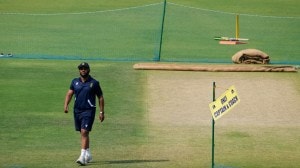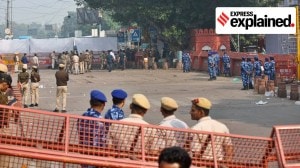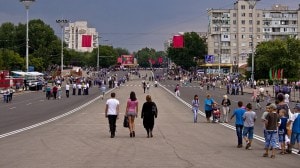Setting an example
Though his biography,Adhunik Yugacha Vishwakarma ,Nitin Chandrakant Desai reveals his journey.
Though his biography,Adhunik Yugacha Vishwakarma ,Nitin Chandrakant Desai reveals his journey. He hopes that the book will serve as an inspiration for young artistes. He talks to Anita Aikara
It all started off back in the ’80s when a determined young graduate from Sir JJ School Of Arts,Mumbai set out to make his mark in Bollywood. He was young and had no filmi lineage to boast of. But he had a strong vision: to create larger-than-life film sets. The young lad was Nitin Desai. Born into a middle-class Maharashtrian family,Desai spent his childhood in B.D.D chawl,Worli. My father worked in a bank. Like every other responsible parent,he wanted me to become an engineer or a banker those jobs guaranteed a good salary and other perks. When my parents heard of my decision to become a set designer they were shocked. The pay in Bollywood was bad. No parent would have wanted their son to join the film industry. But forgoing their worries they supported me. Dad also took a loan to help me, he says.
As it turned out,Desai went ahead to make a fortune as he progressed from a simple 2D photographer to an elaborate art director. Being a student with an elective in photography,Desai chose to create 3D sets over just framing 2D images.
Desai’s first project was Bharat Ek Khoj that aired on Doordarshan. Soon after he got an opportunity to work on Chanakya,his first independent project. With a budget that went into a couple of lakhs,Desai was to recreate parts of the Maurya Empire including Pataliputra and Takshashila in which the serial was fit at Film City,Mumbai. Before building the set he spent weeks at Asiatic Library and Bombay University researching the period. Taken aback by his dedication,the university librarian set up a separate desk for him in the Arts and Culture section so that he would not be disturbed! It was around that time that Desai got the idea of a biography. I searched for Indian books on set designs and found none. I told myself the day I make enough money I would have a biography written, says Desai.
It was not until the the late ’80s that Desai got a break in Bollywood with Vidhu Vinod Chopra’s Parinda. His work did not receive much attention. In 1994,Vidhu Vinod Chopra’s approached Desai for a second time to build the set of 1942-A Love Story. It was no child’s play. I had to create it on a lake. The first problem my team faced was how were they supposed to build a set without measurements. It was impossible. So we kept a check on the lake and when the water level receded my assistants jumped in and took the measurements. Every time the water level dropped,my assistants had to keep rebuilding the set. There needed to be water tankers on standby all the time,just in case we needed water. The biography reveals that while Desai and his men were at their job,Chopra was being continuously dissuaded to drop the idea of building a set on water. People in the industry told the director not to stand by me as I was young. They told him that it was a huge mistake. But he placed his trust in me, writes Desai,who enjoys working on period films. Since then Desai has worked with Chopra on Munnabhai MBBS and Eklavya: The Warrior. But 1942 A Love Story changed the way the industry perceived him. “People started taking me seriously, he says. Desai has an endless list of films to his credit including Drohkaal,Kama Sutra,Hum Dil De Chuke Sanam,Munnabhai MBBS,Eklavya,Jodhaa Akbar,Once Upon A Time In Mumbaai and Bal Gandharva. But the biography states that his most challenging projects were Devdas and Mission Kashmir.
The challenge in creating a set for Sanjay Leela Bhansali’s Devdas was that already two versions of Devdas were made. Bhansali wanted the set to be elaborate and nothing like what he had seen in the earlier films. I scanned through the Pune archives for photographs of the previous films to be sure that there is no duplication, says the art director,who had earlier worked with Sanjay Leela Bhansali on Khamoshi and Hum Dil De Chuke Sanam. Bhansali often gets flak for his elaborate and expensive sets. I had to be sure that he got his money’s worth as it was the most expensive set made in the history of Indian cinema, adds Desai. For the film,a 127-pillar home with no wall in-between was created. Desai started building the set with the house that Aishwarya Rai Bachchan’s character was to stay in. But I spend so much time in the details of the home that Bhansali asked me to rework Devdas’ house. ‘It looked very small when compared to Paro’s home’,the director told me. Chandramukhi’s kotha was built around a lake. When Madhuri Dixit-Nene,who also is my favourite actor,came to visit the set for a dance rehearsal she was completely awestruck. She refused to leave until she had seen the entire set. For the dance sequence Dola re in the film,Desai created a mirror floor with two-and-a-half lakh mirror pieces. Once that was done I realised that the actors might hurt themselves while dancing. So I added a layer on top on the mirror.
As for Mission Kashmir,all of Kashmir was created in Mumbai’s Film City. From the Dal Lake to tiny devastated temples where terrorists sought refuge,every part of the set had been done at Film City. When shooting the climax,cinematographer,Binod Pradhan had problems with the lighting of the set. We resolved the problem in an hour. I covered every piece of visible red earth with grass and burnt it to give the required misty,smoky effect. If you watch the film,you’ll never believe that it has been shot at Film City, he says.As for the Agra Fort in Jodhaa Akbar,Desai worked keeping in mind that red stone was used for construction during Akbars time as opposed to marble in the period of Shah Jahan.
Desai returned to TV with Kaun Banega Crorepati. The hydraulic set that was designed for KBC was different from the one used for Who Wants To Be A Millionaire. I had put up a podium with the computer screen,to seat the contestant and the host of the show,using a hydraulic platform. The London-based agency that worked on Who Wants To Be A Millionaire liked the concept,and asked me for the drawings of the set, recalls Desai. But little did Desai expect Danny Boyle to make a film on the game-show and approach him to recreate the set! He wanted the exact set I had made for the game-show,so nothing changed on screen, he says. For the film,Slumdog Millionaire,Desai created the insides of the Taj Mahal since shooting inside the real Taj was not permitted.
These are fond recollections but Desai admits that his journey in Bollywood was not an easy one. His mother was not way remotely aware of the work he did. For around six years my mom did not know what I did for a living. She thought of me as a sculptor,artisan and a carpenter. It was only when I took her to one of my sets did she understand my job better, he says. He adds,Art directors get very little recognition and have to work through all odds. Earlier there was no paperwork and when art directors signed a project there was no surety that they would be paid at the end of the project. It was all based on trust. Things have changed now. That’s where my biography fits in. I hope young budding artisans read the book,understand the challenges and work their way through all the odds. I used to take photographs of all my sets. At times when my assistants used to pull down the sets,I used to hurriedly start taking photos and had to at times had to move out of the way of falling pillars. I have shared all those photographs and sketches in my biography.
Thinking about and writing Adhunik Yugacha Vishwakarma took longer than Desai had thought it would. Estimating the time the book would take proved to be as difficult as projecting what to include. For eight months Mandar Joshi,the writer,and Desai would sit down together from seven to nine in the morning at the art director’s office as they kept wrapping up chapters. After nine the telephones in my office would start ringing so we used to wrap up our meetings. Then somewhere in the month of May 2011,Desai asked Joshi to stop noting down points and compile the book. And here it is. I hope it stimulates understanding,debate and creative ideas among young artisans. I would be happy if my biography helps millions of young budding artistes who hope to become successful art designers, he says. As for now the art director plans to get more ambitious with his projects. I am building a 127 crore set for a film on Shivaji Maharaj. I promise that the set will be larger than any of the sets you have seen
before.





- 01
- 02
- 03
- 04
- 05


























